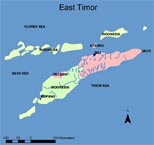Bones are key to truth behind notorious Timorese massacre
 Dili, East Timor - As the official photographer for the thousands of civilians walking to a cemetery for a burial, Simplisio de Deus watched through a camera lens as the Indonesian military slaughtered hundreds at the Santa Cruz Cemetery November 12, 1991. It was the last time he would see some of his friends.
Dili, East Timor - As the official photographer for the thousands of civilians walking to a cemetery for a burial, Simplisio de Deus watched through a camera lens as the Indonesian military slaughtered hundreds at the Santa Cruz Cemetery November 12, 1991. It was the last time he would see some of his friends.
The procession had been organized as a memorial for a young man who had been gunned down two weeks before in a church raid by the Indonesian military. The mourners had hoped for a peaceful march, but De Deus was on hand with a camera just in case anything happened.
Something did happen - a massacre - and it became one of the most important and debated events in Timorese history.
The 1990s were turbulent years in Indonesian-occupied East Timor, but unlike earlier massacres, the Santa Cruz Massacre was the first covered by foreign journalists and it forced upon the world the sights and sounds of an illegal occupation. What the world saw and heard in video footage spurred calls for a referendum vote and, eight years later, Timor finally got that vote for independence.
Today in East Timor November 12 is a national holiday and families spend the day together. In the evening candles line the dark, rain-slicked streets across the young nation. The candles burn in memory of the Santa Cruz dead, their link to independence not forgotten.
Yet, 17 years later, a question lingers: Where are all the bodies? De Deus and other witnesses watched as friends were shot and beaten that morning in the cemetery. Then, later in the afternoon, as the victims lay dead and dying, the Indonesians placed them all in trucks. When the trucks came back, they were empty.
Some in Timor claim that up to 400 people died during or after the massacre, but according to official Indonesian reports at the time, only 19 people were killed. If East Timor can produce the remains of hundreds of victims, there is a possibility of setting the record straight and possibly even prosecution.
The families and friends of the dead just want to know what happened to their loved ones. For years families have been tracking down leads and digging holes in the mountains around Dili, but with little luck. "The problem is, it's hard to find the bones of our friends," said De Deus. "We have a lot of information, but much of it isn't true." Then earlier this year forensic anthropologists from the Victorian Institute of Forensic Medicine in Australia and the Argentine Forensic Anthropology Team agreed to lend a hand. So far they have found nothing though their digs have put to rest one longstanding assumption.
Sometimes the graves are empty.
A parched and desolate creek far from any paved road about a half hour west of Dili has long been thought to be the site of a mass grave. So, beneath a simple metal cross memorial erected in 2000, the anthropological team began its dig in July, but after five weeks they found nothing. A failing, perhaps, of poor eyewitness accounts. "We saw the Indonesians come with trucks and the bodies at around six o'clock in the evening," said Joao Balabo, who, as a boy lived in the area. "But we don't know where anyone was buried because if we had gotten too close to the Indonesians we would have been killed." Luis Fondebrider, from the Argentinian team, said he doesn't doubt bodies were taken to the area, but he said that once the bodies got there, anything could have happened. "Every possibility is open from dumping the bodies in the sea or removing and reburying the bodies," Fondebrider said. In February, he and his partner Soren Blau will try again in Hera, a town 20 minutes east of Dili. Already in Hera civilians have turned up bones believed to be victims of Santa Cruz, though with no forensic expertise their claim is unsubstantiated. Still, De Deus is hopeful. "We think that they'll find stuff in Hera because stuff's been found there already," said De Deus. Still, after one empty site the pressure is on Fondebrider and Blau to find something. "The mothers are worried," said De Deus. "The mothers have experienced some frustration that they've not found the bodies sooner." Fondebrider and Blau say they understand what's at stake. Fondebrider was a member of the team which discovered Che Guevara's grave in South America and Blau has been in and out of Timor for years. "The families are all the same, they all say they want the truth," Blau said. "It doesn't matter the language." (dpa)